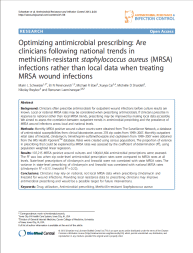October 24, 2013

The Question
Do clinicians prescribe antimicrobials for outpatient wound infections in response to national or local MRSA trends?
What we found
State-level prescription rates for the antibiotics clindamycin and linezolid were correlated with national MRSA wound infection rates, but not with zip code- or state-level MRSA rates.
Why it matters
Clindamycin and linezolid are often used to treat MRSA infections. In outpatient settings, clinicians commonly write antimicrobial prescriptions for wound infections before culture results (and therefore the typeof bacteria causing the infection) are known. Prescribing clinicians must therefore rely on available MRSA rate data to determine whether antibiotics effective against MRSA are necessary for the situation.
This study shows that clinicians may rely on national MRSA rates to inform their prescribing practices, often due to a lack of availability of local MRSA data. If the national MRSA rates are low, a clinician might assume that local rates are also low and that the patient does have not a MRSA infection potentially leading to the prescription of an ineffective treatment. Similarly, high national rates of MRSA could lead doctors to prescribe MRSA-treating antimicrobials for non-MRSA infections. These mistakes not only harm patients by failing to treat their illnesses, but also contribute to the growing problem of antimicrobial resistance.
The authors suggest that making more localized (state- and zip code-level) data on MRSA rates available to clinicians could improve prescribing practices and antibiotic stewardship.

